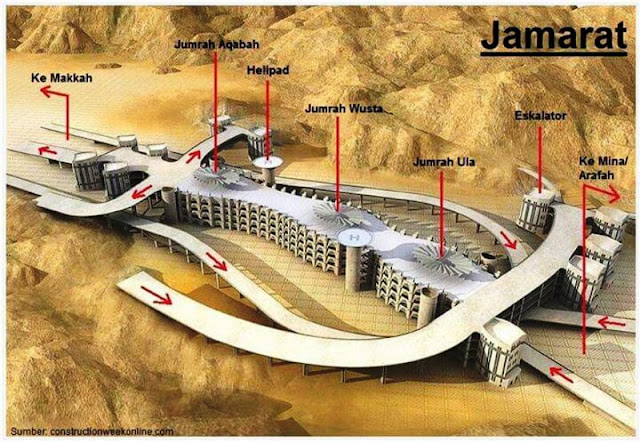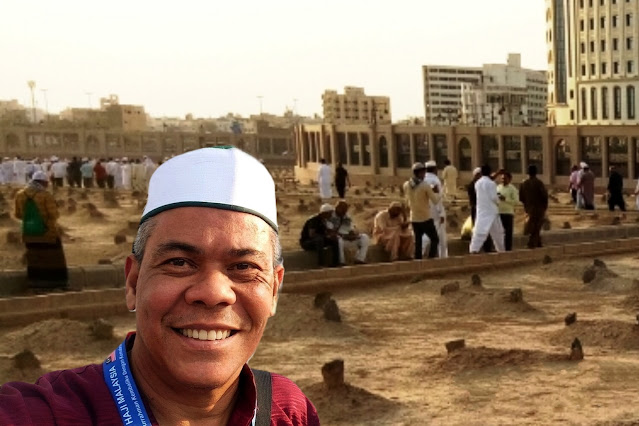Hajj sometimes also spelled Hadj, Hadji on Haj in English is the 5th pillar of Islam and the last obligatory duty in Islam. It occurs in the month of Zulhijjah which is the 12th month of Islamic lunar calendar. The word "Hajj" means "to attend a journey". It is a mandatory religious duty for Muslims that must carried out at least once throughout their lives, they must be physically and financially capable of undertaking the journey, and of supporting their family during their absence from home.
As
one of the 5 pillars of Islam, every year over 3 million Muslims head over to
Mecca, Saudi Arabia to undergo a once in a lifetime obligation to perform the
sacred pilgrimage which is called the Hajj. This is an obligation for those who
can afford it. The Hajj pilgrimage is a thing of beauty, it’s definitely on
every Muslim’s bucket list.
The world wants peace. It started the League of Nations after the First World War but failed. Then it started the United Nations Organisations after the Second World War but has not seen success.
But 14th centuries ago, Islam inaugurated the League of Nations and Annual Conference of Nations have taken place ever since. In Islam, there is the annual gathering of Muslim at Mecca, called the Hajj or Pilgrimage. There, we can see different peoples all forming one family circle and united in one great nationality that of the Muslim.
The present pattern of Hajj was established by Prophet Muhammad (PBUH). However, according to the Quran, the elements of Hajj trace back to the time of Abraham (pbuh). Abraham a.s. was commanded to build the Ka'aba (house of God).
In pre-Islamic Arabia, known as Age of Ignorance (Zaman Jahiliyah), the Ka'aba was surrounded by the Pagan idols. In 630 A.D, the Prophet Muhammad (pbuh) led his followers from Medina to Mecca, cleansed the Ka'aba by destroying all the pagan idols. And in 632 A.D Muhammad (pbuh) performed his only and last pilgrimage with his large number of followers and instructed them on the rites of Hajj. It was from this point that Hajj became one of the 5 pillars of Islam.
At this gathering, we can see Muslims all over the world regardless of races and skin colors, the rich and the poor, master and servant, all dress alike and there is nothing to destroy the unity of Mankind. This ritual is designed to promote the bonds of Islamic brotherhood and sisterhood by showing that everyone is equal in the eyes of Allah. Muslims can feel the real importance of life here on earth and the afterlife, by stripping away all markers of social status, wealth and pride as in the Hajj all are truly equal. All wear simple white clothes called Ihram. Hujaj are there for one common goal and that is to worship the One God and to seek His mervy and forgiveness.
In this pilgrimage, there are many ceremonies to be performed in Mecca, like the circuit of the Ka'aba the "House of God" (Tawaf), visit the hills of Safa and Marwah (Sa'ie), then remain in the valley of Mina, Mudzalifah and Mount Arafat (Arafah) and throwing pebbles etc.
GOING TO MECCA
I
went on Hajj at the age of 56 years in 2017. I registered for Hajj in 2016 and
made a few attempts of Appeal to Tabung Haji (TH) and to Jabatan Hal Ehwal
Veteran (JHEV) Angkatan Tentera Malaysia as a Navy Veteran, and Alhamdulillah I
got the offer to perform Hajj on 2017.
However
this is not the first time for my visit to Mecca and Medina as I have performed
the Umrah in 2015 with my wife, my Sister and my Niece. Hence, it was not the
first time seeing the Ka’abah during my
Hajj. For every Muslim, standing in front of the Ka’abah for the first time was
so surreal as all these while, we could only see Ka’abah on the TV, magazine,
newspaper etc..How would you feel to be in the same area and the same spot where our beloved Prophet once stood.
.jpg) |
| Tawaf around Ka'aba |
 |
| Sa'ie between Safa and Marwah |
 |
| Abraj Al Janadriyyah , the hotel where I stayed during my Hajj in 2017. MASJIDILHARAM The Great mosque of Mecca that surrounds the Ka'aba in Mecca. It is a site of pilgrimage in the Hajj, which every Muslims must do at least once in their live. HOW HAJJ IS PERFORMED The rites of pilgrimage are performed over 5 to 6 days, starting from the 8th of Zulhijjah until the 13th of Zulhijjah. The whole Manasik of Hajj (rituals) started from 8 till 13 Zulhijjah was so meaningful. Here, with a huge crowd of people, I could feel that everyone individuallay got Allah's attention. DAY OF ARAFAH On the 8th of Zulhijjah, the pilgrims again do the Ihram garments and confirm their intention to make the pilgrimage. The prohibitions of Ihram started this day. The pilgrims proceed to Arafah to stay overnight. Arafah is a barren and plain land about 20 km east of Mecca. On the Day of Arafah (9 Zulhijjah) Muslims all over the world, meet together on equal terms on Mount Arafat. All pilgrims stand together shoulder to shoulder in the true spirit of Islami fraternity and pray to Allah. It provides a hint as to what the Day of Judgement will be like. The Day of Arafah is the golden opportunity for the pilgrims to ask Allah for whatever you want and to seek forgiveness for all your sins. The Prophet Muhammad s.a.w said "Hajj is Arafah", meaning Hajj is not complete without Arafah, a pilgrim's Hajj is considered invalid if they do not spend the afternoon at the Arafah. Pilgrims must leave Arafah to Muzdalifah after sunset, the area between Arafah and Mina about 10 km from Arafah, on the evening of that day, to do their evening and night prayer and move to Mina before of after the morning prayer. MINA Mina are commonly know "City of Tents" , a valley located in the Masha'er district in the Mecca province, about 5 km southeast of the city of Mecca. The 3 Jammarat located in the Mina valley are the location of the "Stoning of the Devil" performed between sunrise and sunset in the final days of the Hajj. 10 ZULHIJJAH - STONING OF THE DEVIL At Mina, the pilgrims perform symbolic "Stoning of the Devil" by throwing stones at only the largest of the 3 pillars known as Jamratul Kubra, the remaining 2 pillars (Jamarah) are not stoned on this day (10 Zulhijjah). And finally, the pilgrims are required to cut or shave their heads and take off their Ihram clothes. Subhanallah, it was an eye-opening experience, walking from Mina camp/tent to Jamrahtul Aqabah about 7 km roundtrip from Mina to Jammarah and back, with thousand of people from all walk of life, from all over the world... this experience were unforgettable. Me and my wife at Jammarah Kubra 11th, 12 and 13th ZULHIJJAH On this 3 days, the pilgrims stay at Mina and to repeat the process the stoning os Satan but this time in the 3 pillars (Jamarah Kubra, Jamarah Ula and Jamarah Wusta). On the last day of stoning the devil (12th or 13th Zulhijjah), pilgrims may leave Mina to Mecca before Sunset. At Mecca the pilgrims make the Tawaf Ifadhah and Saie between Safa and Marwah, make du'a and the Hajj is finished. A man who has completed the Hajj is called a "Haji" dan a woman is called "Hajjah". Haji Zulheimy and Hajjah Norziah TAWAF AL-WADAA Finally, before leaving Mecca, pilgrims perfom a farewell Tawaf called "Tawaf al-Wadaa"> circle the Ka'aba 7 times counter-clockwise.. During the journey of Hajj, pilgrims traditionally also travel to the City of Medina, approximately 450 km from Mecca, to pray at Masjid Nabawi (the Prophet's Mosque), to visit the grave of the Prophet (Pbuh), the Quba Mosque, the Uhud Battlefield etc........ before returning to their respective homelands. The 5 Star hotel where I stay in 2017, less than 5 minutes walk from Masjid Nabawi (Prophet Mosque). The sacred Chamber, otherwise known as Raudah Mubarak, is the place where the Prophet Muhammad (PBUH) is buried along with two of his most loyal companions, Abu Bakar as-Sidiq and Umar al-Khattab. The place where the Prophet (PBUH) was buried was in the house of his wife Siti Aisyah where the prophet stayed at the time of his death. This location in Northern Madinah, is where the Battle of Uhud took place in the 3 A.H (624 CE). It was the second between the Muslims and the Pagan Makkan forces following the Battle of Badar. The Quba Mosque located at the outskirts of Medina, Saudi Arabia was the first mosque built by the Prophet Muhammad s.a.w. as soon as he arrived on his emigration from the city of Mecca to Medina. Jannat al Baqi is the oldest and the first Islamic cemetery in Medina. Located in the southeast of the Prophet's Mosque, containss the graves of some of the Prophet family and friends. What we learned from performing the Hajj is that we had to be patient and kind in all the things we do. Be kind to one another and Isya Allah you will be rewarded with kindness too.... performing Hajj has changed my attitude toward life now..Thank you Allah... My advice to those who want to go on Hajj is to prepare your mind and soul for the journey, you need both mental and physical strength to perform the Hajj... I hope that you enjoyed reading about the Pilgrimage to Mecca and I pray to Allah to grant us the health and wealth so we are able to fulfill our Hajj and Umrah...Ameen.... |





.JPG)


.jpg)





.JPG)







.jpg)
.jpg)

.jpg)














































No comments:
Post a Comment